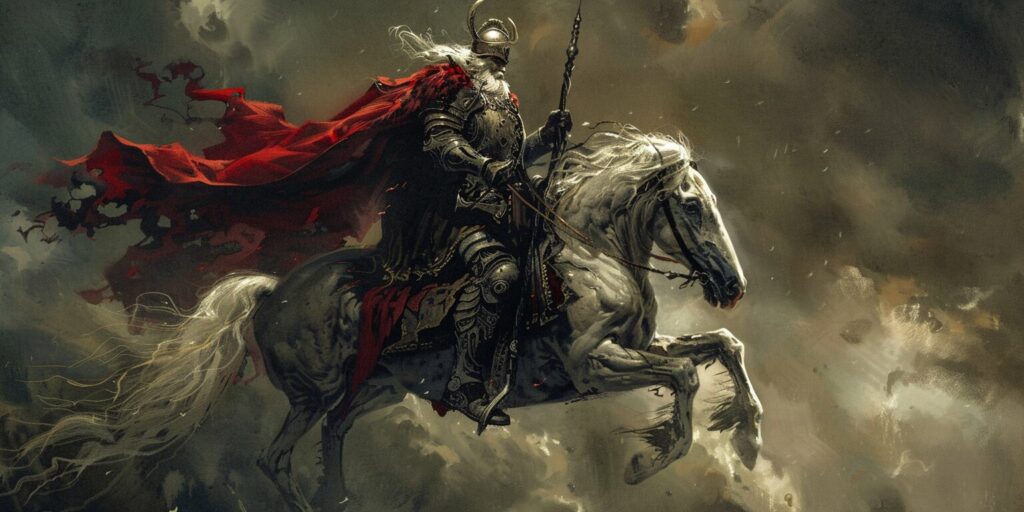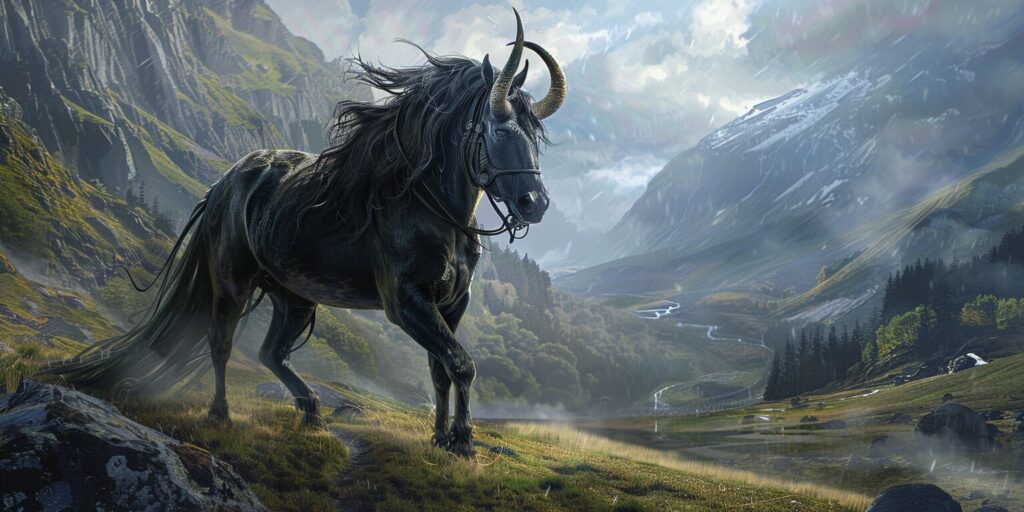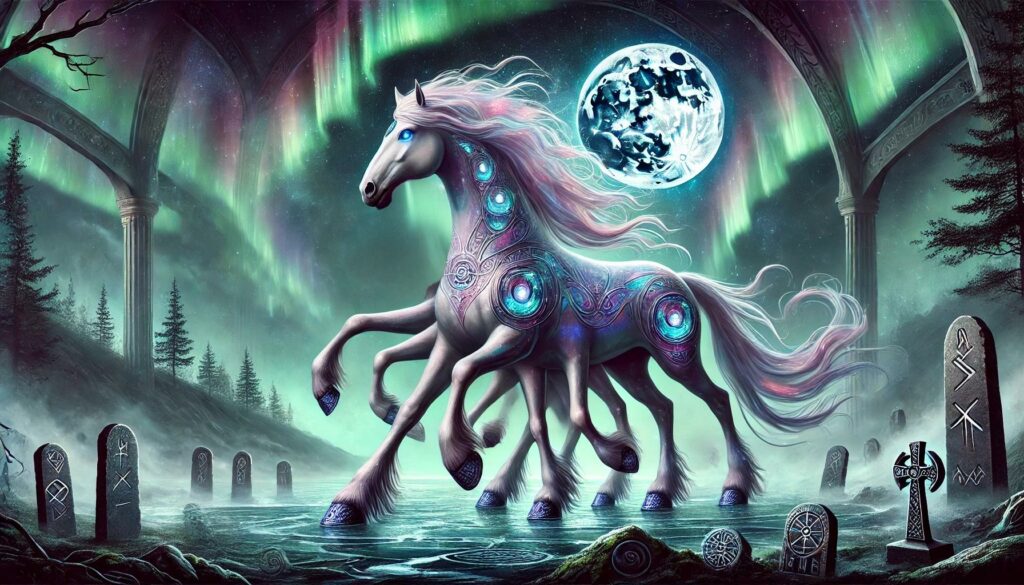Creatures in Norse mythology, Loki, Odin, Sleipnir
The Tale of Sleipnir: Norse Mythology’s Legendary Horse
If you have ever wondered what is the name of Odin’s horse, you came to the right place. In Norse mythology, Sleipnir is a legendary horse known for its eight legs. It’s closely linked with the main god, Odin. Sleipnir is famed for its speed and strength, which show the magical aspects of Norse legends. This part introduces Sleipnir, laying a strong foundation for learning more about its myths and connections with Odin.
Who is Sleipnir in Norse Mythology?
Sleipnir is known as Odin’s loyal eight-legged horse in Norse mythology. He is famous for being unique and symbolic in Asgard, the home of the gods, where even Thor and Baldr acknowledge his importance.
Sleipnir’s Origins and Significance
Sleipnir’s story begins with trickery and magic. He is the result of Loki turning into a mare to mate with Svaðilfari. This unusual birth underlines Loki’s key role in the Norse myths. Being Loki’s child makes Sleipnir stand out, connecting him deeply to the Æsir gods.
Odin’s Connection to Sleipnir Horse
Sleipnir is essential to Odin, symbolizing their close bond and playing a crucial role in Old Norse mythology. He is more than a means of travel, aiding in journeys across worlds. Sleipnir shows loyalty and skill, reflecting the strong partnership between Odin and his remarkable horse.
What are the Legends Surrounding Sleipnir?
Sleipnir, Odin’s eight-legged horse, plays a big part in the Norse myths, especially in the Old Norse sagas. These stories come from works like the Poetic Edda and Prose Edda. They describe how Sleipnir helps Odin with important missions and adventures.
Sleipnir’s Role in Odin’s Exploits
As the god with an eight-legged horse, Odin counts on Sleipnir to cross the Nine Realms. This horse is very fast and nimble, allowing Odin to move quickly, as noted in many Old Norse tales. This helps Odin learn new things, fight in battles, or meet with other deities. The Poetic Edda and Prose Edda share many stories showing how vital Sleipnir is to Odin’s journey.

Connection Between Sleipnir and the Gods
Aside from Odin, Sleipnir is also tied to other Norse gods like Freyja. He has adventures with figures like Loki, known for giving birth to Sleipnir after turning into a stallion. This bond shows Sleipnir’s importance in Norse mythology, bringing a deep link between gods and stories to light, especially described in the Gylfaginning.
Sleipnir’s Unique Characteristics
Sleipnir’s claim to fame is his eight legs and unmatched traits as an extraordinary stallion. These legs give him outstanding balance and speed. With them, he can easily move through any land, even the most dangerous. Sleipnir represents strength and faithfulness, becoming a powerful symbol in Norse tales.
Why is Sleipnir Known as the Eight-legged Horse?
Sleipnir has a unique feature: eight legs, signifying extreme speed and strength. He’s unlike any other stallion in Norse mythology. These extra legs give him unmatched stability as a horse with eight legs. They let him move quickly through the sky and the sea, making him very powerful.
The Mythical Origin of Sleipnir’s Eight Legs
In Norse stories, Sleipnir gained his eight legs through magical and divine means. These legs gave him the ability to move faster than anyone across nine realms, which shows how important he is, especially to Odin, in completing important tasks for the gods.
Sleipnir’s Representations in Norse Art and Literature
In Norse artwork and writing, Sleipnir’s eight legs symbolize his unmatched speed, power, and mystical essence. These depictions go beyond simple decoration. They showcase the core values of Norse culture, including the appreciation of the extraordinary. They also highlight Sleipnir’s status as a legendary being.
How does Odin’s Relationship with Sleipnir Reflect Norse Beliefs?
Odin’s bond with Sleipnir shows how deep Norse faiths go. It shows gods can control nature and magic, as seen in the legends of Thor and Sleipnir. This mix was key in the Old Norse universe.
The Symbolism of Odin Riding Sleipnir
Odin on Sleipnir shows his power in the Norse world. Being Odin’s horse, Sleipnir can move through all realms, galloping effortlessly. Sleipnir’s eight legs add mythic layers like power, magic, and transformation.
Sleipnir’s Connection to the Concept of Travel in Norse Mythology
Sleipnir helps tell stories across the Nine Realms. His speed and the bridges he makes are key to the gods’ lives. His travels show the Norse love for journeys that go beyond just the real world.

Comparing Sleipnir to Other Mythical Creatures in Norse Lore
Amid all Norse myths, Sleipnir is special for his role in helping the gods. Unlike giants or dragons, he directly connects with divine figures. His place as Odin’s horse, Sleipnir, is unique, making him stand out in Norse stories.
What Role Does Sleipnir Play in Norse Mythology’s Pantheon?
Sleipnir is a key character in Norse mythology, symbolizing courage and quickness. It’s the legendary eight-legged horse of Odin, the chief god. Thanks to its speed and remarkable ability to gallop through realms, Sleipnir helps Odin on important quests, showcasing his eight-legged horse status.
Sleipnir’s Interaction with Other Norse Gods and Figures
Sleipnir is not just any horse in Norse mythos; he is often compared to other legendary horses like Gullfaxi. It’s Odin’s trusted mount, taking the god through all realms. This lets Odin meet with other gods and creatures and helps him in battles. Sleipnir’s role connects deeply with the divine actions in Norse stories.
The Lore and Tales Featuring Sleipnir in Norse Sagas
Sleipnir is no ordinary steed in Norse sagas; he’s a horse with eight legs. It plays a crucial role in many stories found in the Gylfaginning. From being a true friend to the gods to standing with them in their toughest times, Sleipnir’s loyalty shines. Its actions show the strong themes of loyalty and endurance in the Norse world.
Conclusion
In conclusion, Odin’s horse name, Sleipnir, stands out in Norse myths for many reasons. He shows us how that culture valued strength, speed, and the magical bond between gods and humans, especially as depicted in Old Norse myths. His story bridges the divine and the ordinary, showing Norse beliefs in a detailed way.
Sleipnir’s lasting impact shows our deep interest in mythical beings and their stories. His connection to Odin highlights the Norse gods’ strong ties with their special animals. Even now, these tales inspire and intrigue people curious about Norse culture.
Sleipnir’s story symbolizes the deep, mysterious forces in Norse myths and the powerful magic depicted in Old Norse tales. They captivate us and help us connect with the Old Norse people’s imagination. Remembering Sleipnir helps us keep in touch with the rich Norse tale-telling tradition, affecting how we see our world today.

